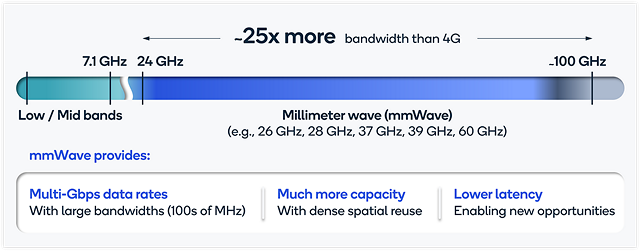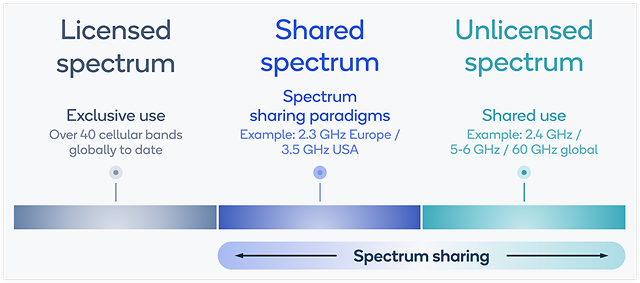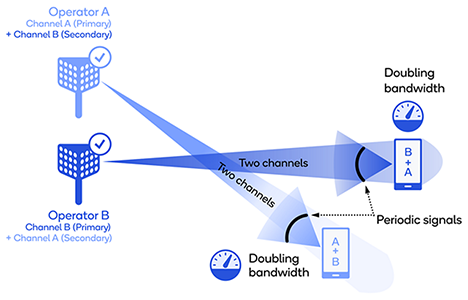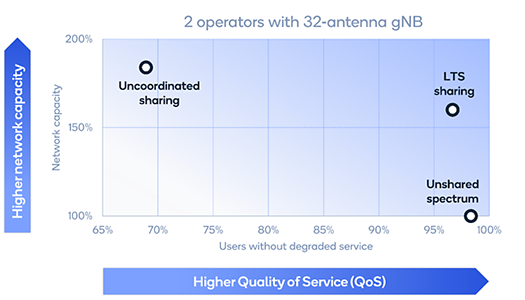Wireless connectivity has transformed the way we live, learn, work, and play. From making personal experiences richer, to collaborating flexibly, shopping confidently, and even tracking our health and fitness, we increasingly rely on wireless connectivity to improve our lives. The indispensable — and limited — resource that makes all this possible is spectrum. As a pioneer of wireless technologies, Qualcomm has developed a way for commercial and federal operators to more efficiently share this vital resource to improve our lives using the latest millimeter wave technology.
Background
Up to and including 4G, cellular networks operated only in frequency bands under 6 GHz. 5G unlocked access to millimeter wave (mmWave) frequencies, which offers approximately 25x more bandwidth than what was available with 4G to meet ever-growing user demand. With mobile data traffic in smartphones having grown nearly 6x from 2016 to 2021 according to the Ericsson Mobility Visualizer, and with mobile data traffic projected to continue growing significantly in the years to come, the demand for more spectrum is increasing. It also brings into focus the need to efficiently use all spectrum bands.

Every day we focus on developing new means of increasing spectrum utilization while maintaining wireless quality of service (QoS). Exclusively licensed spectrum offers mobile operators full access to their licensed channels to support very good QoS. At the same time, spectrum bands used for many other services and applications often are underutilized and can be opened to mobile operations by implementing advanced spectrum sensing tools available today.
Today, many spectrum sharing approaches rely upon geographic separation of co-primary and secondary spectrum users. Secondary users may access the same spectrum as the primary users only if the latter are not subjected to harmful interference thresholds defined by the Federal Communications Commission. However, these sharing methods can be overly conservative and often inefficient. Other spectrum sharing solutions allow dynamic access using spectrum access databases, such as the 3.5 GHz Citizens Broadband Radio Service (CBRS). These solutions improve spectrum utilization in time and space but add operational overhead, complexity, and also can be too conservative when it comes to protecting primary users. Many times, these inefficiencies are due to reliance on conservative channel models to predict interference caused by secondary users to primary users.

Unlicensed spectrum, such as in the 2.4, 5, 6, and 60 GHz bands, provides flexibility for deploying networks with less complexity or overhead. However, since unlicensed spectrum access is uncoordinated and unprotected, reliability is not guaranteed, and QoS suffers as network load increases.
Advanced spatial spectrum sharing
Qualcomm has been working to improve how spectrum can be shared among multiple distinct operators to provide greater spectrum utilization and a guaranteed QoS. We have consistently contributed to regulatory processes to enable a high level of spectrum utilization in diverse bands and types of spectrum. One band provides a unique opportunity to implement a highly desirable spectrum sharing solution.
The FCC allocated the 37.0 to 37.6 GHz mmWave frequency band (the “Lower 37 GHz band”) as a shared licensed band in July 2016 but has not yet adopted a means to open the band for shared licensed flexible uses. Indeed, it is possible to enable in this band the same mobile and fixed operations that the exclusively licensed 28, 37, and 39 GHz mmWave bands provide today. As explained below, it is possible to enable multiple shared licensees to operate in the Lower 37 GHz band on the same spectrum and at the same time and place. Since mmWave antennas create narrow beams to transmit and receive signals, there is a lot of opportunity to more intensively share mmWave spectrum with spatial reuse.

Qualcomm’s filings to open the Lower 37 GHz band to shared licensed access ask the FCC to adopt a Notice of Proposed Rulemaking (NPRM) to allocate six 100-MHz-wide priority licenses in the Lower 37 GHz band and allow each priority operator—which may be a federal government or a commercial operator—to use the rest of the band on a secondary basis. To enable these secondary operations on an interference-free basis, each priority operator would implement a technology-neutral, equipment-based rule to provide coordinated, periodic listening of the channel, referred to as long term sensing (LTS), to determine whether its secondary operations on spectrum outside its priority licensed spectrum may cause harmful interference to the priority license holder of that swath of spectrum. Secondary operations are only allowed for communications links that sensing determines will not cause interference to the priority licensee. The coordinated sensing procedure allows each priority license holder to access all other channels (i.e., the other 500 MHz) on a secondary – and interference-free – basis, increasing overall spectrum utilization while not degrading the QoS for the priority licensee.
This equipment-based, coordinated sensing approach offers improved throughput and highly reliable spectrum access via fast and accurate detection and prevention of potential interference issues. For government and commercial operators, this approach can support a broad range of applications — with ultra-high throughput and high reliability — that other mmWave spectrum bands enable today, such as fixed point-to-point and point-to-multipoint links, mobile operations, private networks, device-to-device (peer-to-peer) connections, and mobile hotspots.

Figure 4 above shows how the sharing approach works. Where the downlink beams from different operators overlap, the potential for interference is detected by equipment seeking to operate in another priority licensee’s licensed spectrum on a secondary basis. In this case, the secondary operator suspends its use of the secondary channel. When secondary spectrum access is unavailable, devices continue to operate on their priority licensed channels without interference and with guaranteed QoS. If the devices move apart so that their beams no longer cause harmful interference, as depicted in Figure 4, operators may resume their use of secondary channels to provide increased network throughput through spatial reuse. The animation in Figure 5 below visualizes these scenarios:
Qualcomm simulation demonstrating how LTS sharing approach works
To quantify the performance of mmWave spectrum sharing using this technology-neutral, equipment-based rule, Qualcomm simulated an airport terminal scenario with two operators sharing the Lower 37 GHz frequency band. Each operator served thirty users using a 200 MHz-wide, priority-licensed channel with six 5G indoor small cells (i.e., gNodeB’s). Each 5G gNodeB had 32-antenna element multiple-input and multiple-output (MIMO) antenna panels. As expected, both uncoordinated sharing and LTS sharing of 400 MHz offered significantly higher network capacity than the unshared spectrum baseline. More importantly however, where the technology-neutral equipment-based rule is implemented, a much higher quality of service is achieved when compared to the uncoordinated sharing method. The proposed approach enables the best of both worlds, meaning, much higher throughput with a QoS equivalent to that available to operators using exclusively licensed spectrum. In the above simulation, Qualcomm determined that multiple operators can provide reliable service with a high QoS akin to that available with an exclusive licensed allocation more than 95 percent of the time and with massive throughput gains by accessing additional spectrum on a secondary basis. In contrast, with uncoordinated sharing across both 200 MHz channels, operators experience capacity improvements but are unable to consistently provide a reliable QoS.

The Commission also can allow indoor use of the entire 600 MHz-wide band by property owners to support smart factories and industrial IoT applications as well as indoor private networks. High levels of building entry and exit signal losses in this millimeter wave band coupled with the highly directional nature of millimeter wave communications would ensure these indoor operations do not harm priority operations outdoors.
Summary
This advanced spectrum sharing approach for mmWave frequency bands uses coordinated sensing to provide several significant improvements to spectrum utilization. The simple, technology neutral, equipment-based spectrum sharing method offers much higher network capacity when compared to exclusively licensed mmWave spectrum. And it allows a significantly better quality of service than uncoordinated spectrum sharing.
This approach provides the advantages of licensed and shared spectrum in a decentralized manner, without relying on connectivity to access control infrastructure or databases that assign available channels. It can be deployed in any band that uses highly directional transmit and receive beams, such as mmWave and other higher frequency bands. As Qualcomm moves to 5G Advanced and 6G, we look forward to helping deliver better user experiences more efficiently, in frequency bands like Lower 37 GHz band, with advanced spectrum sharing.
Watch Aleksandar Damnjanovic, principal engineer at Qualcomm Technologies, walk through our interactive demo for advanced mmWave spectrum sharing











